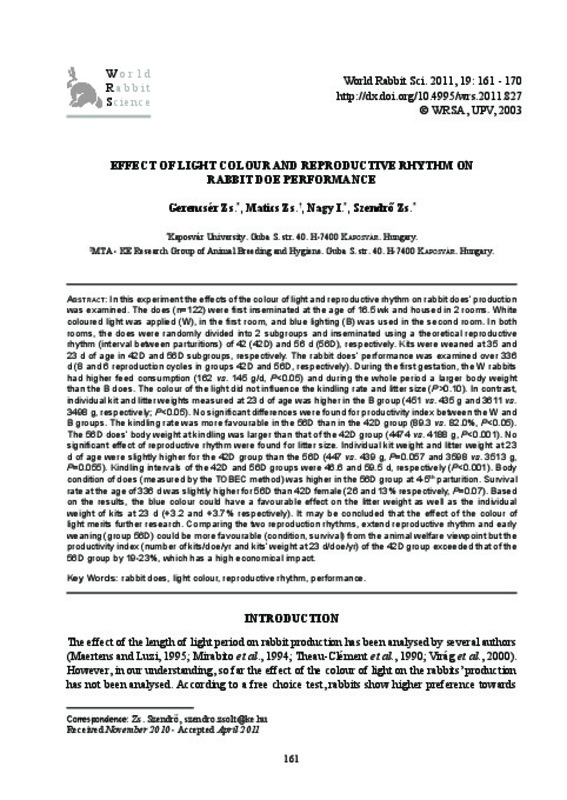JavaScript is disabled for your browser. Some features of this site may not work without it.
Buscar en RiuNet
Listar
Mi cuenta
Estadísticas
Ayuda RiuNet
Admin. UPV
EFFECT OF LIGHT COLOUR AND REPRODUCTIVE RHYTHM ON RABBIT DOE PRODUCTION
Mostrar el registro sencillo del ítem
Ficheros en el ítem
| dc.contributor.author | Gerencsér, Zs.
|
es_ES |
| dc.contributor.author | Matics, Zs.
|
es_ES |
| dc.contributor.author | Nagy, I.
|
es_ES |
| dc.contributor.author | Szendro, Zs.
|
es_ES |
| dc.date.accessioned | 2011-10-19T12:40:52Z | |
| dc.date.issued | 2011 | |
| dc.identifier.issn | 1257-5011 | |
| dc.identifier.uri | http://hdl.handle.net/10251/12206 | |
| dc.description.abstract | [EN] In this experiment the authors examined the effects of the colour of light and reproductive rhythm on rabbit does' production. The does (n=122) were first inseminated at the age of 16.5 weeks and housed in two rooms. In the first room, white coloured light was applied (W) and blue lighting (B) was used in the second room. In both rooms, the does were randomly divided into two subgroups and inseminated using a reproductive rhythm of 42 (42D) and 56 (56D) days, respectively. The rabbit does' production was examined over 336 days (8 and 6 reproduction cycles in groups 42D and 56D, respectively). During the first gestation, the W rabbits had higher feed consumption (162 vs. 145 g/d, P<0.05) and during the whole period a larger body weight than the B does. The colour of the light did not influence the kindling rate and litter size. In contrast, individual and litter weight measured at 23 days of age was higher in the B group (451g vs. 435g and 3611g vs. 3498g respectively, P<0.05). No significant differences were found for productivity index between the W and B groups. The kindling rate was more favourable in the 56D group (89.3 vs. 82.0%, P<0.05). The 56D does' body weight at kindling was larger than that of the other group (4474 vs. 4188g, P<0.001). No significant differences were found for litter size. Individual weight and litter weight at 23 days of age were slightly higher for the 42D group (447 vs. 439 g, P=0.057 and 3598 vs. 3513 g, P=0.055). Kindling intervals of the 42D and 56D groups were 46.6 and 59.5 days, respectively (P<0.001). The condition of the rabbit does (measured by the TOBEC method at 4-5th parturition) was better in the 56D group. Survival rate at the age of 336 days showed a difference (26 and 13% respectively, P=0.07), higher for 56D group. Based on the results, the blue colour had a favourable effect on the litter weight as well as the individual weight of kits at 23 d (+3.2 and +3.7% respectively). It may be concluded that the effect of the colour of light merits further research. Comparing the two reproduction rhythms, group 56D is more favourable (condition, survival) from the animal welfare viewpoint but the productivity index (number of kits/doe/year and kits' weight at day 23/doe/year) of the 42D group exceeded that of the 56D rabbits by 19-23%, which has a high economical impact and determines the reproductive rhythm applied on rabbit farms. | es_ES |
| dc.description.sponsorship | The financial help of TECH_08_A3/2-2008-0384 (OM-00198/2008) project is gratefully acknowledged | |
| dc.language | Inglés | es_ES |
| dc.publisher | Editorial Universitat Politècnica de València | es_ES |
| dc.relation.ispartof | World Rabbit Science | |
| dc.rights | Reserva de todos los derechos | es_ES |
| dc.subject | Rabbit does | es_ES |
| dc.subject | Colour of light | es_ES |
| dc.subject | Reproductive rhythm | es_ES |
| dc.subject | Performance | es_ES |
| dc.title | EFFECT OF LIGHT COLOUR AND REPRODUCTIVE RHYTHM ON RABBIT DOE PRODUCTION | es_ES |
| dc.type | Artículo | es_ES |
| dc.date.updated | 2011-10-18T13:13:13Z | |
| dc.identifier.doi | 10.4995/wrs.2011.827 | |
| dc.rights.accessRights | Abierto | es_ES |
| dc.description.bibliographicCitation | Gerencsér, Z.; Matics, Z.; Nagy, I.; Szendro, Z. (2011). EFFECT OF LIGHT COLOUR AND REPRODUCTIVE RHYTHM ON RABBIT DOE PRODUCTION. World Rabbit Science. 19(3):161-170. https://doi.org/10.4995/wrs.2011.827 | es_ES |
| dc.description.accrualMethod | SWORD | es_ES |
| dc.relation.publisherversion | http://doi.org/10.4995/wrs.2011.827 | |
| dc.description.upvformatpinicio | 161 | |
| dc.description.upvformatpfin | 170 | |
| dc.description.volume | 19 | |
| dc.description.issue | 3 | |
| dc.identifier.eissn | 1989-8886 | |
| dc.identifier.eissn | 1989-8886 | es_ES |








